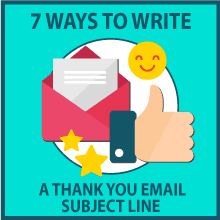
Imagine that you just left a meeting with a potential customer. The discussion went great, although an important detail about your product slipped your mind. Already in the office, you send your lead a thank you email with a subject line that reads ‘Thanks’ — to tell them how much you’re going to enjoy working together and to fill in the blanks.
You feel sure that the deal is closed. The customer promised to ‘get back to you’, but you don’t hear anything the next day. Or the day after that.
At the end of the week, you finally send them another email, only to find out that the potential customer decided to go with your competitor’s product. Their explanation?
‘I didn’t see your follow-up email.’
This theoretical situation highlights just one of the reasons why polishing subject lines is important. It’s a small, but crucial part of your online communications with customers.
Read on if you want to learn how to make it better.
Ignoring thank you emails means squandering some great opportunities
Modern sales representatives know that emails are vital for communications with their leads. But discussions on the internet usually revolve around initial cold emails or follow-ups after no response.
A thank you email after a meeting (no matter if it happened online or offline) can significantly improve your chances to successfully close the deal — if you take advantage of it.
See, humans can only keep four different things on their minds at once. If your lead doesn’t open your thank you email immediately after the meeting, you’re risking that they will forget how great your pitch was when the competition swoops in.
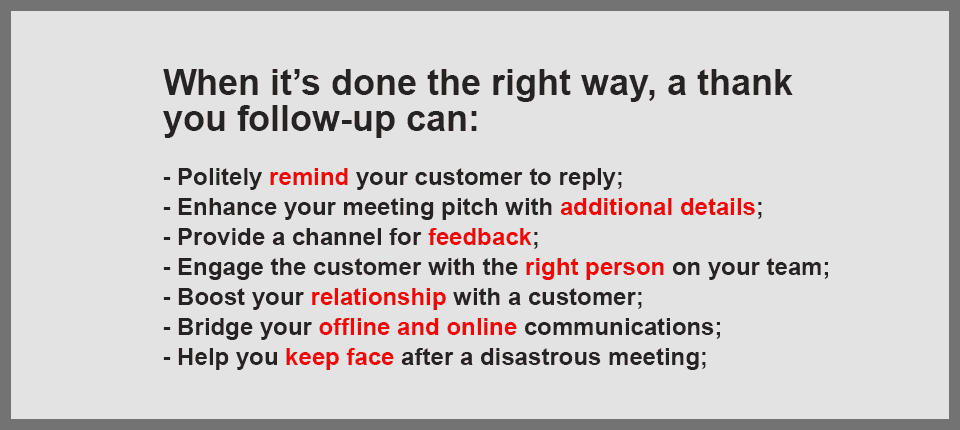
Each of the listed approaches to thank you emails provides a tangible improvement to your communications with a customer. But it’s important to remember that each approach demands a different style — you won’t get away with generic replies.
How to make your thank you email subject line better
Most often thank you emails are sent as a separate message (as opposed to a reply to the ongoing email thread). So the first thing you should do is find a proper subject line to attract your customer’s attention and re-engage them in an online conversation.
Improvement #1: Drop the generic ‘Thank you’ email subject line
If your subject line doesn’t include any details beyond ‘Thank you’, the customer won’t be able to quickly connect the email to the meeting you had.
And this is precisely how emails get ignored.
If your subject line doesn’t include anything but ‘Thank you’, you’re leaving much of the cognitive work for your customer. Nobody likes to spend time investigating exactly what the email is about and why it might be important.
Both of these should be obvious from the get-go!

In the age of phishing and spam, people are not going to open incoming emails left and right. And even if they do, barebones subject lines are annoying, which unnecessarily taints your message.
To reiterate, you’re not sending out messages with blank subject lines — and a generic ‘Thanks’ in the subject line might as well be blank.
The solution? Add some details to make it clear what meeting you’re talking about. Later in this article, we’re going to dissect some specific tactics. But if you take away only one thing from this post, it’s this — stop with the ‘Thank you’.
What about emojis?
Emojis are one of the proven ways to capture attention with your subject line. Although the use of emojis in business emails is growing (according to Automizy), it’s still a guaranteed way to stand out.
A thank you email like this is bound to capture your lead’s attention:

But using emojis can have a lot of drawbacks. If you were talking to a potential enterprise customer, an emoji in the subject line will probably be out of place. And if the meeting was far from stellar, an emoji can be perceived as frivolous, or inappropriate.
Context matters. It makes sense to use an emoji when you were talking to a small business or someone young. Not so much with a 50-something VP of a global company.
As a rule of thumb, only use emojis when you’re 100% sure that the meeting went awesome for both parties. If you feel like you and your lead are on the same wavelength, it’ll work. Otherwise, better be safe than sorry.
Improvement #2: Personalize, personalize, personalize
Personalizing your sales emails continues to be one of the best things you can do to achieve more deals. Treat each of your messages as building blocks for a long-term and valued relationship with your customer.
Though the bulk of personalization will happen in the email body (where you might remind them about the details of your meeting and ask relevant follow up questions), there is no reason why your thank you email should be left out.
The easiest way to accomplish this is by mentioning the recipient’s name:
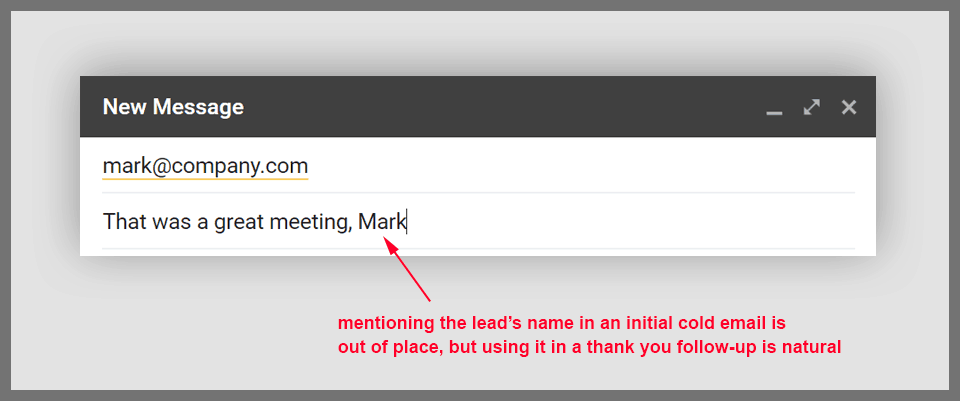
And if the meeting was particularly enjoyable, you can mention some fun details about it.
Here’s a quick example:
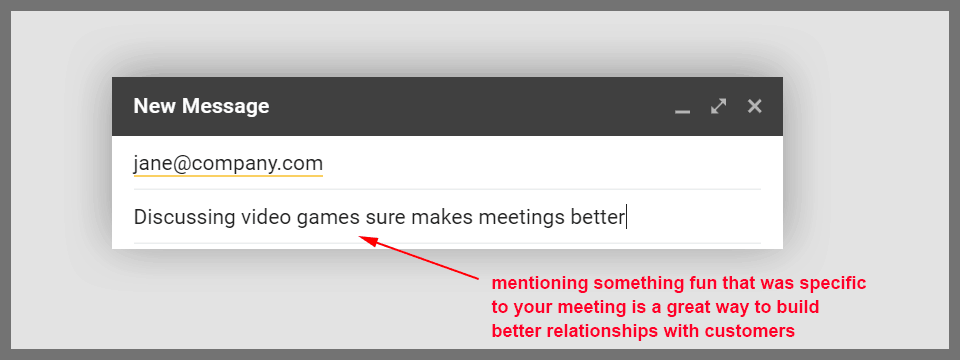
Such an approach will help your customers recognize who you are and what exactly your meeting was about. It will also make their memory of the meeting more vivid and your relationship stronger, which is important if they have many meetings with different sales reps from different companies.
A potential customer may participate in dozens of similar meetings. But only yours featured a heated videogames debate — use such opportunities to stand out!
Improvement #3: Write subject lines that nudge the recipient to reply
Many sales reps approach thank you follow-ups strictly from the point of view of politeness. And that’s why they don’t think beyond subject lines like ‘Great meeting’ or ‘Thanks’.
By going with a status-quo email subject line, many emails miss out on a simple way to re-engage potential customers in a communication. Consider adding a call-to-action to your email to make sure that it gets opened:
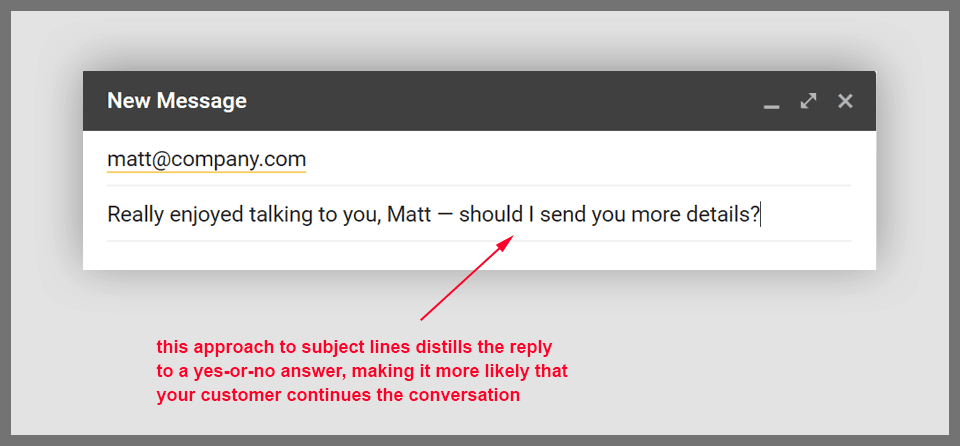
Basically, this email subject line encourages the recipient to reply even before they open your email.
Improvement #4: Ask for feedback from the beginning
A lot of the times you’ll have your own thoughts about the meeting. But what you really need is to hear real feedback from your potential customers.
That’s why you should ask for it right from the start:

Once again, this approach is all about giving your potential customer a clear, actionable step to take. By asking for feedback in such a polite way you’re also being respectful and paying attention to your customer’s needs. Make it clear that you value their thoughts and the liking persuasive technique will do the rest.
Improvement #5: Peak your customer’s curiosity with additional details
The allure of a thank you subject line like the one below speaks for itself. It’s hard not to feel curious and resist clicking on it.
What is it that you forgot to mention? It should be important!

Of course, the trick is supplementing your meeting with something that is worth that curiosity. You can use this subject line when you stumbled upon some new stats that support your pitch — or when you feel like the customer is in doubt and you want to include a healthy discount on the deal (as an example).
It’s also likely that your customer will have a question or two during the meeting that you were not able to address. Pay attention to see if there is something that they are interested in or something that they are mistaken about.
After a meeting, research whatever may have come up and include your feedback in a positive thank you email with a subject line like:

This is the point where we remind you that a lot of the content in your sales emails depends on how useful it is for your customer. Even if the email is no longer cold, don’t forget about it.
Improvement #6: Highlight meeting recap
An easy way to improve your thank you follow-up email is by adding a quick summary of the meeting that took place. This way you’ll be able to reiterate some of the key points of your pitch and make sure that the customer got the right impression.
Your meeting recap shouldn’t be more than a paragraph long. Keep it as brief as possible. And when you’re doing it, make sure that you use the right subject line to minimize the risk of being ignored.
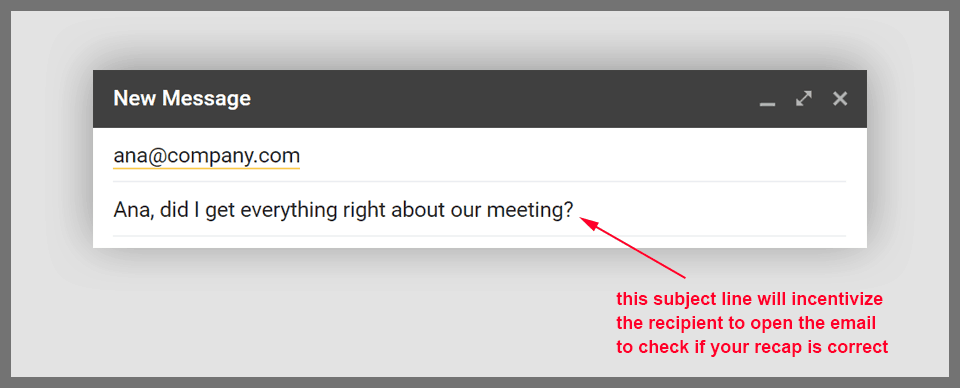
This way you’re packing a double punch. Your summary will make sure that the customer understands the pitch perfectly, and the subject line will not only set the right tone but also improve your open rate.
Improvement #7: Apologize if the meeting went awry
When it comes to email sales tips, most of the advice on the net is skewed towards optimism. The meetings go as planned, deals are closed, and the only reason why you’re sending a thank you email in the first place is to congratulate the recipient on money well-spent.
Of course, things rarely go as planned in real life. That’s why you need to learn how to write a subject line to make sure your emails get opened.
There are various ways in which a meeting can go wrong. Maybe your pitch wasn’t strong. Or you couldn’t connect with the prospect on a personal level. Maybe a water bottle exploded ? Who knows? In all of these cases, a thank-you follow-up is often your best shot at rebuilding some of the goodwill your customer had before going into the meeting. And it begins with a subject line.
Here’s a great example of how you can start gaining trust again with your customer after an awful meeting:
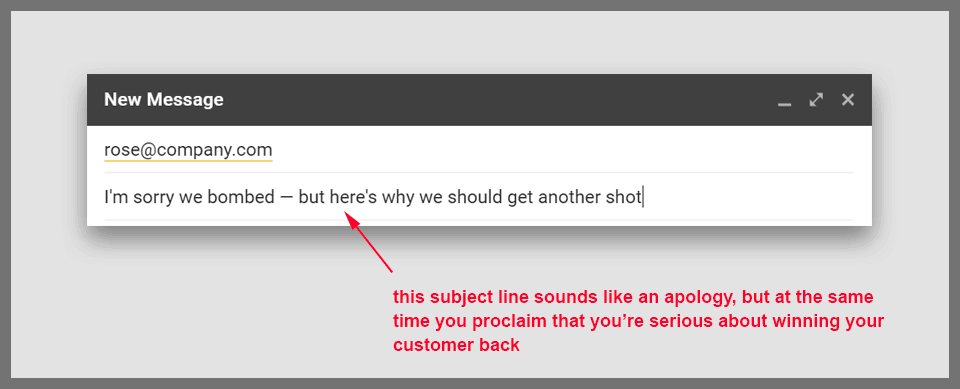
Will it work 100% for all types of disasters? Probably not. But it does offer you a way to regain trust and potentially win you a deal, so don’t ignore it.
Conclusions
So here’s the most important thing about a thank you email subject line.
Keep them short, informative and actionable. Switching between different modes of communication in a fast-paced environment can be hard. Your thank-you email should be a seamless way to get a clear concise message across to your prospect or customer — in a single line.
Do you have experience sending thank you follow-ups after meetings? If you do, don’t hesitate to share your tips with us in the comments section below!

That was quite good and helpful.
wow… this is really helpful